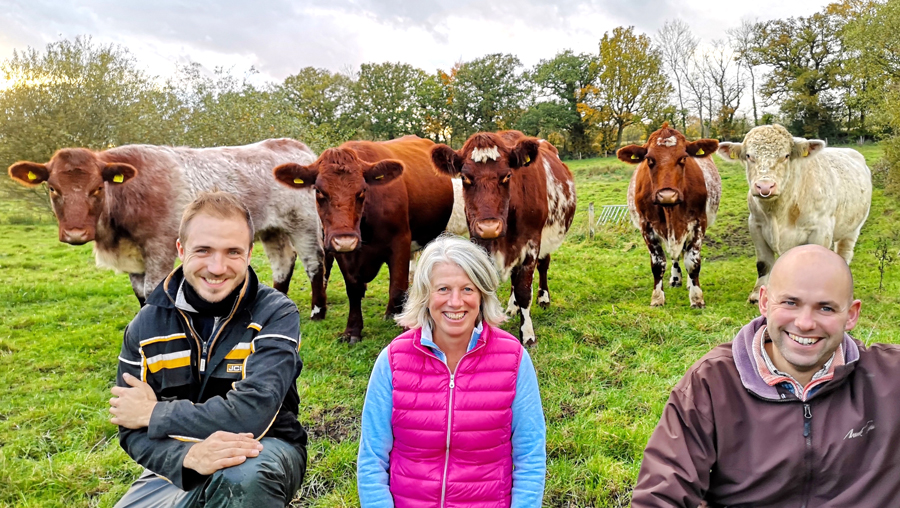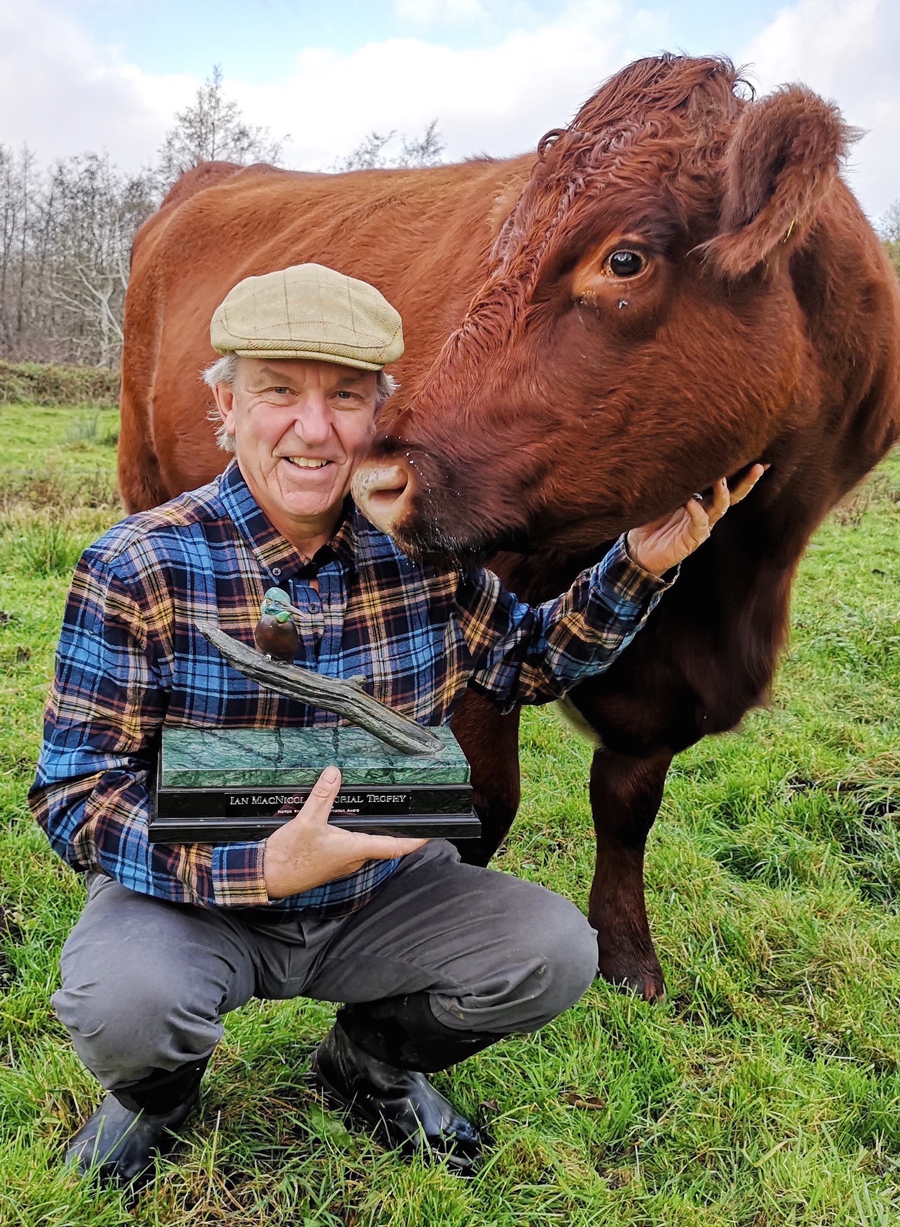An organic farming business looking to the future
22nd February 2021
Introducing Beef Shorthorn – complementing environmental land management schemes.

The Mill Farm team, Mary MacGregor with farm manager Leigh Nobes (r), and stockman Fred Playford (l).
Mill Farm is a 400ha organic unit located near Great Witchingham in the heart of Norfolk, farmed by Duncan and Mary MacGregor. Their drive and energy ensure environmental management goes firmly hand in hand with commercial food production alongside developing their 15-cow Redhazel herd of pedigree Beef Shorthorns. The herd runs alongside a 60-cow grading up suckler herd and 100 Poll Dorset ewes and the unit is in Mid-Tier Countryside Stewardship.
“We would like to be considered as a forward-thinking farming business with an eye to the future. Our ethos is to show we are a top tier performing mixed organic farm that uses nature to help get us to where we want to be – it is integral, absolutely fundamental. We are also carbon conscious,” explains Duncan MacGregor.
“The soil condition dictates the cultivations that will be chosen for any given field, with minimum tillage the key principle. We are even trying no tillage in certain circumstances, which for an organic farm is very difficult to achieve. Both cover leys and companion cropping is part of the strategy.
“The farm works a seven-year rotation with winter wheat, spring barley and oats all grown for seed as the weed burden is kept incredibly low. Beans and rye also form part of the rotation. One third of the acreage is used for building fertility with a multi species grass and legumes ley; this is also grazed by the cattle and supplies the silage for winter feed, meaning the cows are completely grass fed.
“Farm performance is outstanding. As the benefits of the soil conditioning on our sandy loam become more apparent so do the arable yields with good averages of above 5.5t/h with some fields now producing almost into double figures. We are equally proud of the livestock performance for both the pedigree shorthorn and commercial herds whose performance is outstanding.
“However, there is no doubt the farm would be a shadow of itself without the grazing livestock. The pedigree Beef Shorthorns and commercial cattle herd are complimented by the pedigree Dorset Polls and their FYM forms the skeleton to all the farming operations. The muck forms part of the natural lifecycle that creates the conditions for building organic matter and resilience into the soil. It also plays an important role in the life chain which starts with the insect life in and on the soil. This succession of insect abundance goes on in turn to provide year-round habitat and food sources for all the species on the farm.
“The 28ha of water meadow in two valleys grazed by the animals provide species-rich habitats; the five herons in residence that move with the cows prove that the lifecycle is successfully operating. We have had three severe droughts, however the crops have stood up incredibly well because of the excellent soil condition. We believe we can mitigate a lot of the adverse variables by getting the bricks and mortar right.”
Duncan, you are an artist, why invest in a farm business?
Painting has been my main career for over 20 years but we always had a hankering to become farmers and prove to ourselves that embracing natural principles could help build farm profitability. Five years ago, we had a chance to farm Mill Farm which had been organic for some 15 years. Mary comes from a farming background and her brother farms in the Midlands.
On meeting Leigh Nobes, the farm manager, we instantly knew that we could build on the farm’s strong foundations; Leigh is an expert in both arable and stockmanship and has over two decades experience on the farm. That decision has proved to be a perfect marriage as we all share a huge passion for the land, the livestock and towards achieving success.
Why a suckler herd?
The livestock is at the heart of the farm, both emotionally and financially. Without their FYM the soil would soon become impoverished. The muck does not just provide fertility but also contributes to the whole biology through the mycorrhizal fungal and bacterial activity that kick starts and feeds the soil, which makes it more resilient to, for example, pests and diseases and drought.
We inherited a 60 cow suckler herd made up of a mixed bag of breeds but we wanted to develop a pedigree herd too. The cattle between them play a key role in maintaining the diverse species rich habitats that would otherwise be dominated by more aggressive species and leave room for the insects and mammals to thrive.

Duncan MacGregor with Redhazel Lady Broadhooks and the Farm Conservation Award presented by Norfolk FWAG.
Why a native breed?
We spent a lot of time considering the various options. Leigh was already experienced with continental breeds and their focus towards muscle which was a direction we did not want to go in. We were after a native breed because that is what they are: native. They have evolved in the UK which is reflected in their behaviour and what and how they eat. Their thicker skins also help with our climate.
It had to be Beef Shorthorn?
Yes. We had witnessed the breed had great maternal traits and that has proved to be the case. Beef Shorthorn milk well and make great mothers looking after their calves. We liked their personality and their temperament – the fact they are consistently friendly and easy to handle without being too touchy feely.
We were aware that Beef Shorthorns thrived on 100% grass diets which is important for the farm as they are either grazing the permanent pasture or the clover leys. Watching their grazing preferences when we rotationally move them onto new pasture is fascinating: some head straight onto the clover – rich in protein and minerals; some to the bird’s foot trefoil which is a dewormer, and others to the willow – a source of aspirin. Their desire for a varied diet is part of what makes them such an interesting animal. This in turn makes them a quality beef animal with provenance – an indigenous breed worth preserving.
Next steps
The plan was always for the Beef Shorthorn pedigree herd to supersede the commercial herd over time. This will be done gradually by buying in top class animals into the herd and growing our own on. We also wanted to show that by using Shorthorn bulls in the commercial herd, the subsequent quality of calves was proof this was very commercially viable.
Top quality is our mantra and our focus on personal handling, EBV’s and linear classification means we can be very selective and prescriptive. In that way, we can carefully select for specific traits and values and temperament. We are using Breedplan to help the selection process and aim to be in the top 10% linear classification. This successful strategy will be borne out by this year’s calves: we will keep the heifers but the very good-looking bulls calves will be sold next year.
What’s the future?
Redhazel will be a top tier herd in terms of Beef Shorthorn performance recording and linear classification along with excellent temperament and high welfare. Bulls are being bred for both the pedigree and commercial sector and we would like to become the go-to herd for replacements. The cattle enterprises will be profit centres in their own right and continue to contribute to the Environmental Land Management scheme, the diversity of the farm and companionship to everyone working at Mill Farm.
